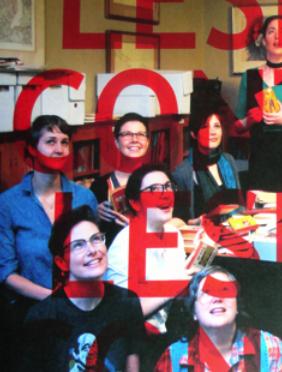
Images like this appear in Lez Con. Credit: Provided by Cressida Frey of the CLGA.
The Canadian Lesbian and Gay Archives boast more than 5,000 vertical files; about 7,000 individual periodical titles; thousands of photographs, videos and tapes; and a National Portrait Collection. But comparatively few of these materials relate to queer women.
“There is a noticeable imbalance in our collection, and, I would suspect, in other LGBT archives. Maybe 25 percent,” estimates Kate Zieman, an archivist and CLGA volunteer. “There just hasn’t been the same volume of material created for queer women as there has been for men . . . If we don’t make the effort to recover and preserve our stories, it makes it that much easier to ignore our existence and the incredible gains that we’ve made.”
Lez Con, an exhibition curated by Fredericton-born, LA-based artist Onya Hogan-Finlay and currently running at the CLGA, seeks to correct this imbalance. Lez Con, named for a play on the term Can Con, playfully investigates lesbian content in the archives.
“There are a lot of personal histories and narratives in the Lez Con exhibition — some of them accessible to the public, some of them not . . . Anyone who’s LGBT can donate to LGBT archives. That’s a pretty unique premise for collecting,” says Hogan-Finlay.
The exhibition features materials from the 1980s and onwards, including posters, books and paraphernalia such as a Hitachi Magic Wand, reusable menstrual pads and handkerchiefs — objects that are associated with lesbian culture but that might not be visible in any other exhibition. It also includes elements from Hogan-Finlay’s personal narrative. One section is also dedicated to Will Munro, a gay artist and activist known for supporting the lesbian community. Several of Munro’s vinyl records are on display, along with a jacket he stitched for Hogan-Finlay.
“I really wanted to focus on lesbian representation and ideas about regulated representation,” says Hogan-Finlay. “Displays of archival material can help resonate the richness and variety, but also lack thereof, that exists.
“The histories of trans people or intersex people, people of colour and lesbians are not the majority of the holdings.”
Lez Con also offers a different perspective by showcasing queer women’s views of their own culture.
“In addition to highlighting lesbian sexualities, eroticism and lifestyles, it effectively challenges the heteronormative gaze instead of portraying the typical pornography or sex shops that we’re confronted with, which are usually pretty degrading to women and limiting to sexuality in general,” says Cressida Frey, the CLGA’s new exhibition coordinator.
Lez Con is presented parallel to Coming After, an exhibition at the Power Plant that focuses on the transformation of gay and lesbian identity into queer identity and culture, as well as the practices of queer artists who came of age after the 1970s.
“The AIDS crisis and gay activism and the transformation of gay and lesbian identity into queer identity . . . had a transformative impact,” says Jon Davies, who curated Coming After and encouraged Hogan-Finlay to apply for her exhibition at the CLGA. “While other exhibitions capture a feeling, atmosphere or sense of arriving somewhere too late, I was interested in capturing what it means to come of age after this decisive, cataclysmic moment in queer history.”
The Deets:
Lez Con: An Exhibition by Onya Hogan-Finlay
Canadian Lesbian and Gay Archives
Runs until Tues, April 10
34 Isabella St
Coming After
Runs until Sun, March 4
The Power Plant
231 Queen’s Quay W
thepowerplant.org

 Why you can trust Xtra
Why you can trust Xtra


